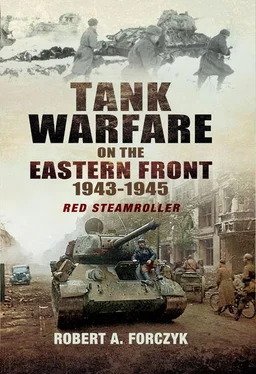On the German side, LSSAH had six Panzergrenadier-Bataillonen and SS-Sturmbannführer Martin Gross’s II./SS-Panzer-Regiment 1 (about 40 Pz IV and 5 Pz III) deployed just southwest of Prokhorovka, with the 13./SS-Panzer-Regiment 1 (four Tigers) deployed further behind the line. The SS-Panzerjäger-Abteilung 1 had at least one platoon of five Marder III tank destroyers deployed in direct support of the Panzergrenadiers. The LSSAH had good communications with its artillery and it had established a strong anti-tank defence to cover the open ground looking toward Prokhorovka. Around 0830 hours, the Soviet ground attack commenced as General-major Boris S. Bakharov’s 18th Tank Corps and General-major Ivan F. Kirichenko’s 29th Tanks Corps attacked, advancing side-by-side across a narrow front. The two Soviet tank corps deployed four tank brigades with 234 tanks in the first echelon (with desant infantry riding on their decks), one tank and one mechanized brigade in the second echelon and one tank brigade in the third echelon. These two formations comprised more than half of Rotmistrov’s attacking force on 12 July, advancing with 350 tanks and self-propelled guns. The Soviet tanks had to cross about 1,500 metres of open ground but due to black, grimy smoke hanging over the battlefield and the numerous gulleys, the Germans only caught glimpses of a mass of armour advancing. Obersturmführer Rudolf von Ribbentrop, commander of the 6.Kompanie, was the closest to the approaching Soviet armour and was first alerted when Panzergrenadiers began firing purple flares, indicating tank attack. {114}
Rotmistrov’s armour came on quickly, surprising the Germans, but the Panzergrenadiers opened fire with all their anti-tank weapons and called in artillery (although it is extremely difficult to direct indirect fire onto moving vehicles). Ribbentrop’s 7 Pz IVs knocked out a number of tanks from the 170th Tank Brigade but lost four of its own tanks as the Soviets assaulted through their position. Although wildly inaccurate, Soviet T-34s were firing on the move and did score some hits at a range of 200 metres. SS-Sturmbannführer Joachim Peiper’s Panzergrenadiers were forced to fight a close-quarter battle with Hafthohlladung (magnetic hollow charge mines) as Soviet tanks and desant troops virtually landed on top of them. In just 30 minutes of fighting, the Soviet armour managed to overrun the LSSAH ’s outer defences and a few tanks even managed to reach the supporting German howitzers. However, Rotmistrov’s attack suddenly came to grief when it unexpectedly encountered the anti-tank ditch lost the previous day. Apparently, Rotmistrov’s tankers were unaware of this obstacle and German accounts claim that some T-34s ran at full speed into the ditch. In any case, the lead four Soviet tank brigades came to a halt in the open, on the far side of the ditch. They had no engineer support. Gross counter-attacked the stalled Soviet armour with his 33 tanks, plus Ribbentrop’s remaining 3 Pz IV and the 4 Tigers; at a distance of about 800 metres they shot two of the lead Soviet tank brigades to pieces, claiming over 60 kills. The Soviet 170th and 181st Tank Brigades tried to skirt around the flank of Gross’ Panzers but were engaged by the four Tigers and methodically destroyed. {115} Meanwhile, part of Kirichenko’s 29th Tanks Corps attacked SS-Obersturmführer Albert Frey’s SS-Panzergrenadier-Regiment 2, located in the Storozhevoye woods. Frey’s Panzergrenadiers were supported by five Marder III tank destroyers under the command of SS-Oberscharführer Kurt Sametreiter, which knocked out 24 tanks from the approaching 25th Tank Brigade. By 0900 hours, Rotmistrov’s first echelon brigades had been badly defeated, but the second echelon advanced at 0920 hours to renew the attack. The 53rd Mechanized Brigade made a particularly deep penetration, getting past the anti-tank ditch, but suffered over 1,100 casualties in the process. After a bit of a lull, the third echelon attacked after noon, but was easily repulsed.
Further south, the Das Reich was screening an extended front, 13km wide. The SS-Panzer-Regiment 2 had no operational Tigers remaining, but its single Panzer-Abteilung had 18 Pz IV, 34 Pz III and several captured T-34s. The 2 TC and 2 GTC did not attack until 1140–1200 hours, by which point Rotmistrov’s main attack had already failed. These two corps launched a number of armoured jabs but suffered moderate losses and failed to penetrate Das Reich ’s lines. When heavy thunderstorms began in the late afternoon, both Soviet corps suspended their attacks. Altogether, Rotmistrov’s four tank corps had 359 tanks and self-propelled guns were knocked out (of which 152 were later repaired). Kirichenko’s 29th TC was the hardest hit, having lost 153 of 199 AFVs. Rotmistrov’s personnel losses were 3,563 (including over 1,500 dead or missing) including two brigade commanders. {116} German losses were modest, with LSSAH suffering 374 casualties and it had about 10–12 Pz IV and 1 Tiger knocked out. {117} Das Reich ’s casualties were about 211 and it apparently suffered no tank losses. {118}
There were two important postscripts to the Battle of Prokhorovka. First, even as Rotmistrov’s armour was attacking, the Totenkopf moved its two Panzer-Abteilungen (with 54 Pz III, 30 Pz IV and 10 Tigers) across the Psel River pontoon bridges and attacked northward against positions held by the 95th Guards Rifle Division. Concealed anti-tank guns inflicted significant losses upon SS-Sturmbannführer Georg Bochmann’s SS-Panzer-Regiment 3, but Bochmann’s panzers broke through the Soviet positions and pushed north. However, Bochmann advanced into a hornet’s nest and the 33rd Guards Rifle Corps massed the fire of over 200 multiple rocket launchers and several howitzer regiments against the German spearhead, inflicting great damage to the accompanying SPWs and wheeled vehicles. Bochmann’s panzers managed to advance 5–6km by 1730 hours – the deepest advance achieved by the Germans during Zitadelle – before he decided to halt. Nipe claims that 45 of Bochmann’s tanks were knocked out or disabled, including all 10 Tigers and that Totenkopf suffered 316 casualties. The commander of the Tiger-Kompanie was killed in action. Interestingly, Zetterling’s statistics claim that Totenkopf suffered only a single Pz III disabled on 12 July, but clearly that is out of synch with actual participants’ accounts. {119} In addition to losses, the appearance of the fresh 24th Guards Tank Brigade and 10th Guards Mechanized Brigade from 5 GMC, with over 100 tanks, was also discouraging. At this point, Bochmann’s panzers were low on fuel and ammunition and had limited infantry and artillery support to engage another strong enemy force. Bochmann halted his advance for the night.
The other major postscript involves the belated advance of Breith’s III Panzerkorps to link up with II.SS-Panzerkorps at Prokhorovka. Breith’s corps had suffered heavy casualties in trying to close up on Hausser’s right flank and by 11 July, the III. SS-Panzerkorps only had about 105–110 tanks still operational, of which 31 were Pz IVs and about a dozen Tigers. In a desperation play, the 6.Panzer-Division mounted a night infiltration attack on the night of 11–12 July with Major Franz Bäke’s II./Pz.Rgt. 11 (about 20 tanks) and the SPWs of II./Pz.Gren.Rgt. 114, moving in column with two captured T-34s at the front. [30]Amazingly, Bäke’s panzers were able to approach the Soviet-held bridge over the Northern Donets at Rzhavets before being identified. After a wild mêlée in which a company of T-34s were knocked out at point-blank range, Bäke and the Panzergrenadiers captured the damaged bridge and created a bridgehead over the Northern Donets. {120} By early morning, Breith’s remaining armour was pushing west across the river, threatening to cut off three Soviet rifle divisions and to link-up with Das Reich . However, nobody bothered to inform the Luftwaffe that Rzhavets had been captured and the Panzergruppe headquarters was bombed by several He-111s, which wounded the commander of 6.Panzer-Division and killed the commander of Panzergrenadier-Regiment 114. {121} In addition, Oberst Hermann von Oppeln Bronikowski, commander of Panzer-Regiment 11, was wounded and four battalion commanders were also casualties. {122} Although Bäke would lead a remarkable armoured assault northward on 13–14 July, it was essentially too late since Hitler had already decided to call off Zitadelle .
Читать дальше








![John Stieber - Against the Odds - Survival on the Russian Front 1944-1945 [2nd Edition]](/books/405234/john-stieber-against-the-odds-survival-on-the-russian-front-1944-1945-2nd-edition-thumb.webp)



